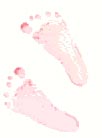

Delivery


When it comes to dilation one check by your nurse could be 6 centimeters and a hour later you could be at 8 centimeters. As your cervix grows larger you'll start to feel pressure in your birth canal and as time goes by the pressure starts to grow as baby slowly moves closer to the entrance of the birth canal. I know this may sound a little crude but the best way I can describe it is your body has the feeling like you are going to the bathroom but not urinating if you know what I mean only the sensation is coming from a totally different area.
Once you reach 9 1/2 -10 centimeters dilated (which is the furthest you can dilate) the nurse will get your room ready for the big event. While one nurse brings in the "baby station" another nurse will be getting you and your bed ready for delivery. If you have a fall away bed the nurse will take one part of a two piece, possibly three piece mattress off at the end of the bed, and dismantle the bed to where there is half of the bed you are on so the bed looks almost cut in half. The nurse will lift the bed a little and lift the back of the bed so you are in almost a sitting position. After that she will pull out and attach or unfold two leg holders that are almost similar to the stirrup leg holders in your OB's office but they fold up in the air so your upper leg near your knee can be placed in the holder so your legs are near your chest and your legs are spread apart for delivery. Since your legs are numb and you won't be able to lift them on your own you will need to have your partner or a nurse help lift your legs into the holders and unfortunately if you try to help by lifting your legs with your arms your legs will feel like they weigh a ton to you. After your legs are in position a paper blanket will be draped over your legs and waist mainly so you don't have to see what is going on down there as you deliver. Your OB or the OB on call may be there to help put you in the leg holders instead of the nurse if the OB shows up early. If your bed isn't a collapsible bed then the nurse will help you to the end of the bed were either the bed will hold you up into a sitting position or your partner will hold you up. And your knees will be placed onto the bed close to your chest.
The second nurse will bring in the other equipment needed along with a "baby station: which is almost like a tall square little changing table with glass sides and a bright overhead light, After baby is born that "baby station" is where they will clean baby up and make sure that baby is ok and breathing normally.
Once your OB or the OB who is on call has arrived he/she will check your cervix and by then chances are baby's head will be visible at the opening of the birth canal. Once the top of baby's head is visible the OB will instruct you to hold onto the handle bars of the leg holders if handle bars are available and when you have the next contraction you would need to pull your knees to your chest and you or your partner will could to ten while you push and stop once your partner is done counting and start all over again when the next contraction starts until baby has been delivered which is usually 3-5 pushes. While you are in that whole process the OB will tell you when he/she can see the head, shoulders and usually after the shoulders come out, baby is easy to come the rest of the way out. As soon as baby's head pops out (depending on how the OB practices) the nurse assisting the OB or the OB will take a bulb syringe which is basically a rubber suction device that sucks out mucus and amniotic fluid from baby's nose and mouth so baby can breath and cry. Some OB s will wait until baby is pulled out before suctioning baby's nose and mouth. Once baby has started to cry and is pulled out the rest of the way also depending on how the OB practices he/she may lay baby on your stomach for a few minutes wrapped in a blanket so you can see your new baby and then take baby for a little while to have the umbilical cord cut and